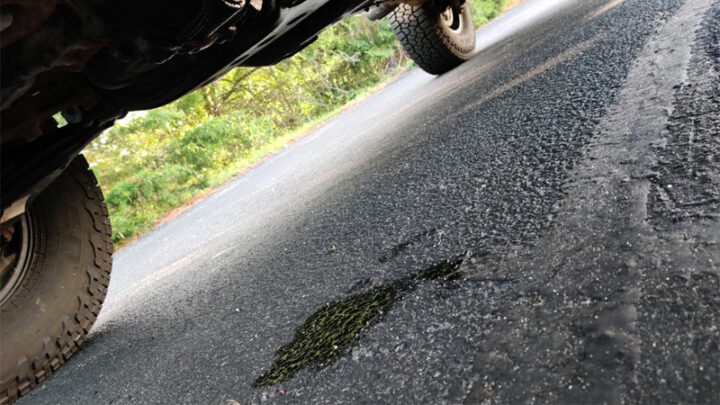Front Differential Leaking? (What To Do and Average Repair Cost)
Has your Jeep Wrangler, Chevy Silverado, or other 4WD vehicle suddenly sprung a leak in its front differential? Chances are your vehicle’s front diff is slowly leaking precious gear oil, putting the 4WD system at risk.
If so, you’re likely concerned, and have more than a few questions regarding how best to proceed. Here’s everything you need to know about aggravating front differential leaks so you can properly diagnose the issue and get it fixed.

See Also: Different Types of Differentials
Symptoms of a Front Differential Leak
A front differential leak can be tricky to diagnose, but by being aware of some common signs, you’ll stand a better chance in preventing additional damage stemming from excessive fluid loss.
#1 – Unexplained Oil Puddling Beneath Vehicle
It’s fairly common to find unexplained oil puddles underneath the front of vehicles with a front differential leak. As the front differential loses oil, it will drip down onto the ground, leaving puddles of oil especially where your car is most often parked.
The oil is usually a light brown or amber color. Pay attention to where the puddles are forming, as oil directly under the front differential indicates that is the source of the leak.
#2 – Whining Noises When in 4WD
Engaging four-wheel drive relies on the front differential to deliver power to the front wheels. If the front differential is low on oil, activating 4WD can produce loud whining noises as the gears struggle to mesh properly.
The lack of oil causes increased friction and noise from the differential. The whining tends to worsen when turning corners while in 4WD. This audible symptom usually means the front diff fluid level is critically low.
#3 – Unnatural Hesitation When Cornering in 4WD
In addition to whining noises, a low front differential fluid level can cause hesitation and loss of power when turning corners in 4WD mode. There may be delayed reactions from the front wheels or jerky sensations as you turn the steering wheel.
Without enough lubrication, the front differential gears struggle to transfer power properly, leading to inconsistent power delivery. This hesitation is most noticeable at lower speeds.
#4 – Excessive Metal Shavings in Magnetic Drain Plug
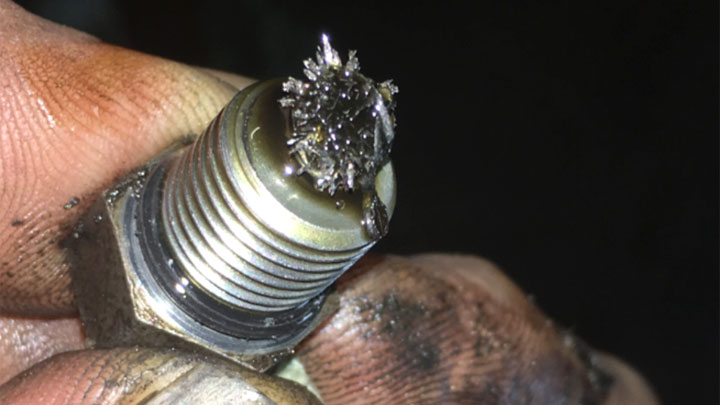
When changing the front diff fluid, be sure to inspect the magnetic drain plug. Lots of metallic debris clinging to the magnet is an indicator of internal wear happening inside the differential.
Small amounts are normal as gears operate, but excessive particles usually mean accelerated wear is taking place due to insufficient oil lubrication. Addressing the leak early on can prevent catastrophic damage to the front differential.
What Can Cause a Leaking Front Differential?
Front differential leaks tend to originate from one of several different sources, some of which are more concerning in nature than others. By understanding these potential causes, you can get ahead of leaks that appear, before they become extreme in nature.
The following are several potential causes of a leaking front differential.
#1 – Differential Housing Seal Leak
The differential housing seal prevents oil from escaping at the mating surfaces between sections. Over time, normal wear and age can cause these seals to leak.
#2 – Leaking Input Shaft Seal
The input shaft seal mounted on the rear of the front differential prevents gear oil from leaking out around the driveshaft connection. If this seal is damaged or worn out, it can leak easily.
#3 – Leaking Inner Axle Seals
The axle shafts passing through the differential housing rely on inner seals to contain oil inside. When these seals fail due to general wear, oil can leak through.
#4 – Outer Axle Seals
Front wheel hub assemblies also use seals to retain gear lubrication around the axle shafts. Failure of these outer seals will result in leaks.
How to Fix: Though technically more of an axle/hub style leak front axle/wheel seal leaks are common, and rather aggravating. Depending upon the vehicle in question, you'll be required to remove the offending wheel seal or gasket with the appropriate tooling.
After thorough surface prep is complete, a new seal or gasket will be applied and seated as necessary. Reassembly of the problem hub will be the reverse of disassembly.
#5 – Compromised Differential Housing
Though rare, it is possible for a front differential to crack or bust. This is generally the result of undue stress related to impact of one type or another.
How Much Will It Cost to Repair a Front Diff Leak?
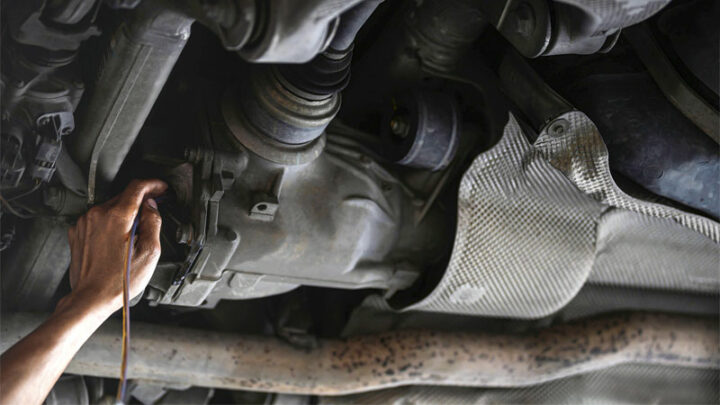
Exact costs associated with repairing a front differential leak often differs from one particular model of vehicle to the next. Nonetheless, there is an average range, in terms of cost, that most repairs of this type fall within.
Generally speaking, you can expect to pay between $250-$500 to reseal a leaking front differential, assuming that no internal differential damage has been incurred.
If major failure necessitates differential replacement, this price jumps considerably, peaking at over $2,000 in most cases. Of course, repair of performance or exotic vehicles will be exceedingly expensive.
Is It Safe to Continue Driving?
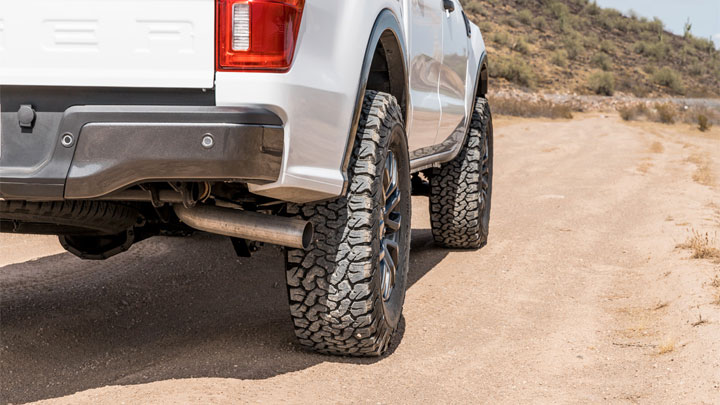
You should never, under any circumstances, ignore a differential leak, no matter which differential it originates with. With this being said, it is acceptable to drive as necessary to get from one destination to the next until a differential leak can be repaired, assuming that the leak in question is not severe, and you are keeping a close eye on the fluid level therein.
However, you must also consider that differential leaks do not fix themselves, with many worsening with the passage of time and the accrual of miles.
Simply ignoring a differential leak is an obvious misstep, and one that can possibly lead to costly repairs in the future. Addressing the situation at hand in a prompt manner is always cheaper than postponing repair and hoping for the best.
In any event, a front differential leak should be addressed and satisfactorily repaired as soon as possible. Doing so will minimize the risks associated with complete differential failure, at the hands of lubricant starvation.
If you do not feel comfortable tackling such repairs yourself, you should schedule an appointment with a qualified mechanic as soon as possible to have the front differential leak properly diagnosed and repaired.
What Can Happen If You Ignore the Leak
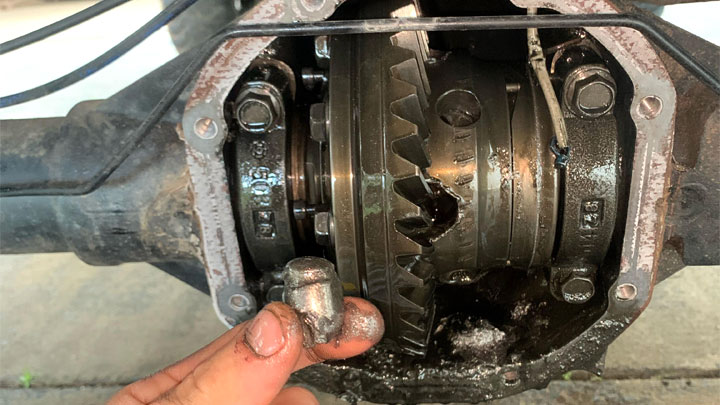
There is significant risk associated with ignoring a differential leak. Differential fluid/gear oil contained within a differential is used to cool and lubricate the gear sets contained therein. With enough time, it is possible for a differential to lose enough fluid that lubricating and cooling properties become compromised.
Without sufficient lubrication, a differential can quickly begin to overheat, due to harsh metal-on-metal contact between the assembly’s ring and pinion gears. The further you drive, the more excessive this heat becomes.
In the most extreme cases, a vehicle’s differential can actually lock-up while in operation, as the result of significant fluid loss, thereby posing a substantial safety hazard.
Do All Vehicles Have a Front Differential?

Not all vehicles have a front differential. In fact, the use of a front differential is largely contained to 4WD or AWD vehicles. This stems from the fact that standard RWD trucks/SUVs do not feature powered front axles, and FWD vehicles control independent front axle speed via the transmission.
A vehicle’s front differential is engaged via the vehicle’s 4WD system via an auxiliary transfer case. This assembly serves as a mechanical link between the vehicle’s front and rear axles.
When engaged, a transfer case allows power to be distributed to a 4WD vehicle’s front-driveshaft and differential, thereby powering the vehicle’s lead axle.
- P0480 Code (Symptoms, Causes, and How to Fix) - Apr 19, 2024
- Car Temperature Gauge Stopped Working? (Here’s Why) - Apr 15, 2024
- Ignition Coil vs Coil Pack (What’s the Difference?) - Apr 8, 2024

